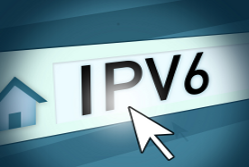Why your business needs IPv6
Why your business needs IPv6
 One of the internet’s fundamental technologies is changing. David Barker, founder and technical director of 4D Data Centres explains IPv6 and why your business should be deploying it.
One of the internet’s fundamental technologies is changing. David Barker, founder and technical director of 4D Data Centres explains IPv6 and why your business should be deploying it.
IP stands for internet protocol. It’s a key part of the technology that enables most internet-connected computers to communicate.
An IP address is the unique label given to every device connected to a network (or to the internet). In the same way that your home address enables letters to reach you, an IP address enables devices on a network to send data to each other. An IP address looks something like this: 192.168.12.4.
From IPv4 to IPv6
IPv4 is (unsurprisingly) the fourth revision of the internet protocol and the most widely used today. However, it is also fairly old - it was originally ratified in 1981.
In total IPv4 has capacity for 4,200,000,000 unique IP addresses. Back in 1981 they assumed that would be enough to cover any possible eventuality. It’s lasted three decades, but there are now so many devices in the world that need to connect to the internet (each requiring its own, unique address) that we’re running out of room.
Step forward IPv6 (IPv5 was an experiment). It provides a massive increase in the number of addresses available. This means an IPv6 address looks very different to an IPv4 address – usually something like: 2001:cdba:0000:0000:0000:0000:3257:9652. Sometimes all zeros are omitted to save space, leaving a colon marking the gap: 2001:cdba::3257:9652.
IPv6 was designed from the ground-up to allow for an enormous number of IP addresses. There are enough for computers and mobile phones and household appliances and cars.
In total it provides roughly 340,000,000,000,000,000,000,000,000,000,000,000,000 unique addresses. To put it into perspective, that’s 480,000,000,000,000,000,000,000,000,000 addresses for each of the seven billion people on the planet.
Should you worry about IPv6?
It’s vital your business starts thinking about IPv6 sooner rather than later. If you don’t introduce it to your network then over the next few years there will be parts of the internet that you simply won’t be able to access.
Once we’ve completely run out of IPv4 addresses, companies will be forced to deploy new services as IPv6-only. This is already starting to happen in Asia. For instance, operators in countries such as China are running on IPv6-only as they don’t have enough IPv4 addresses to support the number of people going online.
What’s more, if you introduce IPv6 early, you’ll have more time to learn how to make use of new features that IPv6 includes. A lot of these are technical features to improve data routing and security but there may also be ways to make money from IPv6. Perhaps you can take advantage of new services, or drive your own markets by showing your customers that you are an early adopter.
What you can do next
After reading this article you should know that IPv6 exists and it’s important you adopt it sooner rather than later – that’s a good start!
Now, here are four more steps to help your business get ready:
- Start by testing your existing internet connection to see if it is IPv6-enabled. You can do this easily online, right now. This website is especially helpful because it will tell you how prepared your internet service provider (ISP) is for IPv6. You can use the test results when talking to your ISP about its plans for IPv6.
- Make sure that your office network will run on IPv6. Firewalls are the key here as IPv6 support on firewalls has been fairly limited until recently. Your PC and ISP might be IPv6-enabled but if the firewall only talks IPv4 it will need replacing. It’s worth raising this with your IT supplier now, so you can budget for changes if required.
- Make sure your website (plus any other public servers) are running on IPv6 as well as IPv4. Over time, devices will begin to only support IPv6. You don’t want your website to drop off the internet as this happens. Your web hosting company should be able to advise.
Has your IT supplier mentioned IPv6? Is this the first you’ve heard of it? Leave a comment to let us know.
- For more information about IPv6 and how to switch, download 4D Data Centre’s white paper: IPv6: A Primer.
- The internet is running out of room




Comments
Add a comment